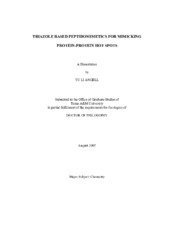| dc.description.abstract | Copper-mediated alkyne-azide cycloadditions yield 1,4-disubstituted triazoles
with high chemoselectivity that can be used in many ways. For instance, when alkyne or
azido peptide units combine via this pathway the reaction is relatively insensitive to the
amino acid side-chains. This serves as an excellent way to produce peptidomimetics,
particularly because there is some stereoelectronic similarity between 1,2,3-triazoles and
amide bonds.
Linear peptidomimetic substrates 60 were used to form the cyclic derivatives 61
via copper catalyzed azide alkyne cycloadditions. This reaction is fast, simple to perform
and compatible with many solvents and functional groups. A library of eight cyclic
peptidomimetics was prepared in solution and the low yield was mostly due to formation
of dimers. Computational, NMR, and CD analyses of compounds 61a-c indicate that
their most favorable conformational states include type I and type II β-turn
conformations.
Monovalent triazole mimics were prepared via cycloaddition reactions in solution.
These triazole compounds contain two amino acid chain functionalities at 1- and 4-
positions. One is derived from a natural amino acid and the other is a functional group
that resembles the side chains of an amino acid. The 1,3-dipolar cycloaddition reactions
allow quick and efficient generation of the desired peptidomimetics in good yields.
Two monovalent mimics were coupled to the linker scaffold sequentially in
solution by simply manipulating the solvent systems. This method allows us to prepare
large libraries of bivalent compounds quickly and efficiently. The two monomers were combined with each other cleanly, to achieve one-compound-per-well in sufficient purity
for biological testing.
Oxidative coupling to give 5,5’-bistriazoles is discussed. The bistriazole products
predominate in the copper accelerated “click reaction” of alkynes and azides when
carbonate bases are used as additives (ca 1 – 2 M). The reaction seems to be more
efficient for propargylic ethers and less hindered substrates. Use of optically active
azides could afford separable atropisomeric products, providing a convenient access into
optically pure derivatives. | en |


